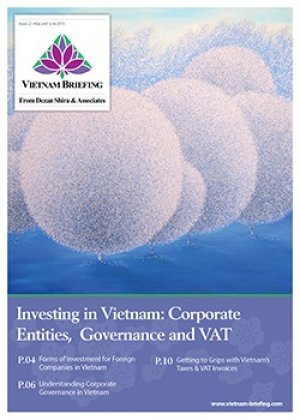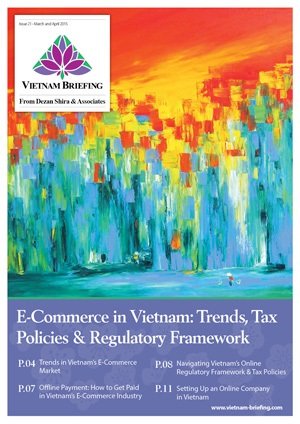Trademarks in Vietnam – Part Two
By: Dezan Shira & Associates
Editor: Ellena Brunetti
 In part two of this multi-part series, Vietnam Briefing takes a closer look at trademarks, how to get them, and their enforcement in the country. Please click here to read part one.
In part two of this multi-part series, Vietnam Briefing takes a closer look at trademarks, how to get them, and their enforcement in the country. Please click here to read part one.
In terms of obtaining a trademark, Vietnam is like many of its ASEAN neighbors in adopting a “first to file” registration system, meaning the first party to file the mark has rights to it granted. This article will examine both national and international strategies for trademark protection in Vietnam.
There are two ways for a trademark owner to protect their trademark within Vietnam:
- Applications can be made either for international registration designating Vietnam through the World Intellectual Property organization, under the Madrid system;
- Applications can alternatively be made directly in Vietnam for national registration, through the National Intellectual Property Office (NIPO)
Process for international registration of trademark
The Madrid system that is governed by the Madrid agreement and the Madrid protocol provides one single procedure for the filing, registration and maintenance of trademarks in several territories, as long as those territories are party to the system. Registration of a mark under the Agreement provides for the legal equivalent of registration in member countries designated by the trademark owner.
The Agreement also provides for a simplified renewal system since registration to renew the original registration can be made through a single filing with WIPO.
Thus, it can be a smart choice for investors willing to invest in more than one country to think about international registration rather than national registration of their trademark, as there are numerous advantages. Indeed, instead of filing several applications in multiple countries, applicants can file only one application in one language and one currency and for renew, just one date to monitor. Moreover, this mechanism is time-saving, as offices of the designated country do not need to conduct formal examinations.
 RELATED: Dezan Shira & Associates’ Corporate Establishment Services
RELATED: Dezan Shira & Associates’ Corporate Establishment Services
Regarding the process to obtain international registration, investors should follow the following procedure:
Applicant files International application (IA) and designates countries
Step 1:
Before filing an international trademark registration, the applicant must first register its mark with the IP office of its home country (called the “office of origin” in the Madrid system). Indeed, it must be applied in home country before the protection can be awarded in Vietnam. This application is called a “basic mark.”
Once this has been done, the applicant (who can either be a physical person or a legal entity) should get an application file for international trademark protection, and then drop it at the relevant office of origin.
Regarding the content of the international trademark application form, it must designate one or more Contracting Parties in which the mark is to be protected (this stage is called in the Madrid system “ the designation”, that is the indication of one or more contracting parties where the protection of the mark is indented).
It must also contain at least:
- A reproduction of the mark (which must be identical with that in the basic mark registration)
- A list of the goods and services for which protection is sought, classified in accordance with the International Classification of Goods and Services (Nice Classification).
The international application is received at the Office of Origin and it is forwarded to WIPO.
Step 2: Formal examination by WIPO
Once the application is received by WIPO, it will conduct a formal examination of this application, but no substantive examination, as this one will takes place during the third stage.
Once approved by WIPO, the mark is recorded in the International Register and published in the WIPO Gazette of International marks. A certificate of international registration will then be sent to the mark maker, and WIPO will notify the designated office in Vietnam and the ones of all other territories in which the mark maker would like to extend the trade protection.
Step 3: Substantive examination of the international registration by the Office of the designated Contracting Party
A substantive examination of the IR will be conducted by the Vietnamese National Office of Intellectual Property (NOIP).
If the trademark office of the designated country does not communicate a refusal of registration to WIPO within 12 months (extended to 18 months under the Protocol) the mark will have the same protection as registered national marks in that country. In this case, this office will issue a statement of grant of protection to the mark owner. The trademark will then be protected in Vietnam during 10 years.
Process for national registration of trademark
Vietnam is a first-to-file jurisdiction. In other words, that means that the first party to file a trade mark application in Vietnam will be the one to whom the NOIP will issue a trade mark registration. Thus, unlike some countries (called “first-to-use” jurisdiction) where trade mark rights can arise from simply using the trademark, trade mark rights in Vietnam arise only upon registration with Vietnam’s National Office of Intellectual Property (NOIP).
For this reason, investors should take the time to register and maintain their trade marks in Vietnam.
To be able to be registered in VN, a trademark must comply with the definition and conditions of the Vietnamese law as described in the first installment of this series. Moreover, such a registration can be refused on absolute refusal grounds or relative refusal grounds.
Whereas any legal entity or natural person can oppose the registration of a Vietnam trademark on absolute refusal ground, only a third-party already holding similar rights on the same trademark can oppose relative refusal ground.
 RELATED: Trademarks in Vietnam – Part One
RELATED: Trademarks in Vietnam – Part One
According to the article Section 73 of the IP Law, absolute refusal grounds can be opposed for trademarks that are considered as being contrary to the public, such as trademarks consisting of signs identical with or confusingly similar to national flags or national emblems, names of Vietnamese State bodies or leaders, or seals belonging to international or national organization.
According to the article section 74 of the 2009 IP laws, relative grounds for refusal registration relate to conflicts with earlier trade mark rights belonging to third parties, which occur when the trademark consists of signs being identical or confusingly similar to the mark of another party that has already been registered.
Thus, to avoid the possibility of potential rejection or a risk of opposition, it is highly recommended to conduct a pre-filing search before registering a trademark in Vietnam.
In case of an application for the registration of a mark identical or similar to an earlier mark of another party, a written agreement in the form of a letter of consent from earlier right holders could be provided, but the NOIP in such case may still refuse registration if it considers that the registration of the second mark may lead to confusion. Thus, it should be clearly stated and proved in the letter of consent that the simultaneous use of the marks by both parties concerned will not cause confusion amongst the public.
Regarding the documents to be provided in the application, the mark application shall consist of the following documents:
- A request made in prescribed form (as prescribed in the Circular No. 01/2007/TT-BKHCN);
- Documents, samples, information identifying the mark as provided for in Articles 105 of the IP Law 2005 of Vietnam. Vietnam has adopted the classification of goods and services as specified in the Nice Agreement for the purposes of trademark registration although Vietnam is not a member of the Nice Agreement;
- Power of attorneys, if the application is filed through a representative;
- Documents evidencing the priority right, if claimed;
- Receipt of fees and charges.
Exceptions to first-to-file
It is important for investors to note, however, that as a party to the Paris Convention, Vietnam has committed itself to give a special protection to well-known trademarks. Thus, special legal regime applies to the trademark that are defined as “well-known”, as the rights to a well-known mark are derived from use, not registration, knowing that this use does not even need to occur in Vietnam, according to the article 6Bis of the Paris Convention.
However, as the concept of being “well-known” has not been clearly defined in the Convention, its definition varies amongst signatory states. In Vietnamese law, Well-known trademarks are defined by the Article 4.20 of the Law on Intellectual Property (IP Law) as “a trademark widely known by consumers throughout the territory of Vietnam”.
Therefore, before filing any registration application, investors should check whether or not their trademark falls under the scope of “well-known” trademarks as defined by Vietnamese law.
|
Asia Briefing Ltd. is a subsidiary of Dezan Shira & Associates. Dezan Shira is a specialist foreign direct investment practice, providing corporate establishment, business advisory, tax advisory and compliance, accounting, payroll, due diligence and financial review services to multinationals investing in China, Hong Kong, India, Vietnam, Singapore and the rest of ASEAN. For further information, please email vietnam@dezshira.com or visit www.dezshira.com. Stay up to date with the latest business and investment trends in Asia by subscribing to our complimentary update service featuring news, commentary and regulatory insight. |
Investing in Vietnam: Corporate Entities, Governance and VAT
 In this issue of Vietnam Briefing Magazine, we provide readers with an understanding of the impact of Vietnam’s new Laws on Enterprises and Investment. We begin by discussing the various forms of corporate entities which foreign investors may establish in Vietnam. We then explain the corporate governance framework under the new Law on Enterprises, before showing you how Vietnam’s VAT invoice system works in practice.
In this issue of Vietnam Briefing Magazine, we provide readers with an understanding of the impact of Vietnam’s new Laws on Enterprises and Investment. We begin by discussing the various forms of corporate entities which foreign investors may establish in Vietnam. We then explain the corporate governance framework under the new Law on Enterprises, before showing you how Vietnam’s VAT invoice system works in practice.
E-Commerce in Vietnam: Trends, Tax Policies & Regulatory Framework
In this issue of Vietnam Briefing Magazine, we provide readers with a complete understanding of Vietnam’s e-commerce industry. We begin by highlighting existing trends in the market, paying special attention to scope for foreign investment. We look at means for online sellers to receive payment in Vietnam, examine the industry’s tax and regulatory framework, and discuss how a foreign retailer can actually establish an online company in Vietnam.
 Tax, Accounting, and Audit in Vietnam 2014-2015
Tax, Accounting, and Audit in Vietnam 2014-2015
The first edition of Tax, Accounting, and Audit in Vietnam, published in 2014, offers a comprehensive overview of the major taxes foreign investors are likely to encounter when establishing or operating a business in Vietnam, as well as other tax-relevant obligations. This concise, detailed, yet pragmatic guide is ideal for CFOs, compliance officers and heads of accounting who need to be able to navigate the complex tax and accounting landscape in Vietnam.
- Previous Article Vietnam Regulatory Brief: Pharmaceuticals, Eased Visa Restrictions for US Citizens, and the Finance Ministry’s e-Portal
- Next Article Vietnam Regulatory Brief: Import and Export Procedures, Changes to the Investment Law, and VAT Holidays










